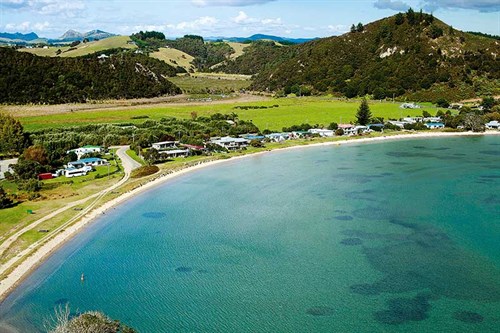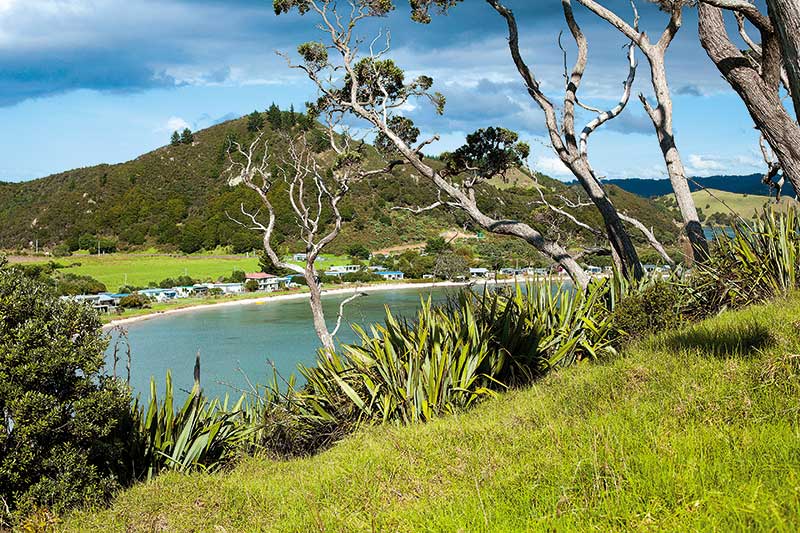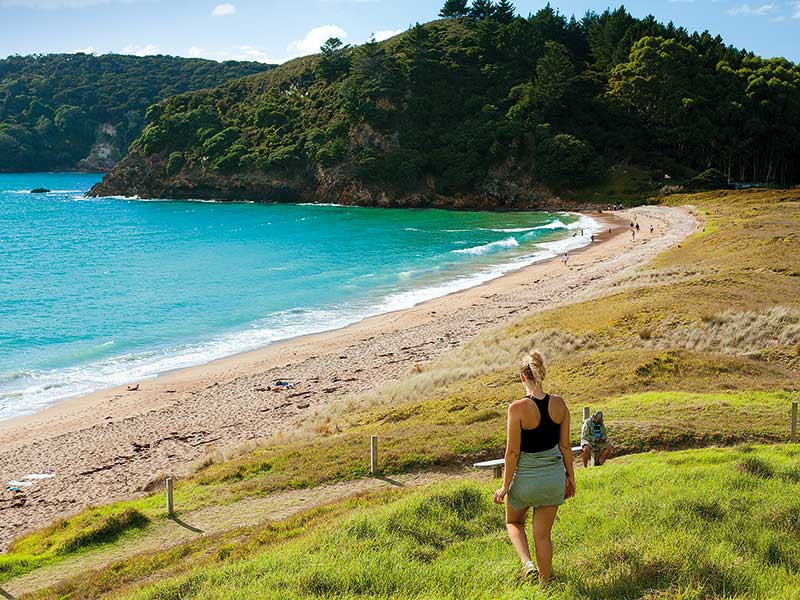From anywhere within Pataua estuary is a view of varying-sized green humps and hills. The most obvious and attractive is the cone on Pataua Island, known locally as Pataua Mountain, only it’s not really a mountain, and it’s not an island, but a decent hill just the same.
Appearing like an island, straddling Pataua estuary and the Pacific Ocean, native bush like pohutukawa form a band around its base, its middle third is mainly grass, parts of it terraced from its days as a Pa site. Its top is covered in native trees. One of the earliest written accounts of Pataua was in 1820 when Samuel Marsden stayed on the Pa, sheltering from a storm while travelling north.
After a 30-minute drive from Whangarei, once we’ve driven over the windy road we’re met by mangrove trees before arriving at Pataua South, a sleepy coastal village that curves around one section of the estuary. The modest baches mostly look across the still water to a glimpse of Pataua North, the small opening where the Pacific Ocean enters into the inlet and, rising above them both – Pataua Mountain.
We lounge around for a few days, in and about our newly acquired caravan. At low tide we wander to the water and join black oystercatchers to pick about in the sand between shells and seaweed, foraging for pipi and cockle shells. We walk to the surf beach and loll about in the gentle waves, Pataua Mountain is always within view, from each angle it takes on a different shape.
The only caravan and camping site is Treasure Island and from its amenity block situated on a hill I look across to the grassy hump that leads up Pataua Mountain.
Access to the track is gained from a car park near Treasure Island Campground. A sandy walkway leads over a large sand dune to a pretty surf bay, Papuni Beach. To the left, at the base of the mountain track, a large slab of weathered wood makes a smooth seat.
A DOC sign points out the area is culturally significant, apart from once being a Pa site, Maori used to bury their babies’ placentas in the sand dunes. Moa bones were discovered in the late 1800s and every so often pre-European remnants are found from when Ngapuhi used the area as a resting place when returning from Rotorua.
The grass track that leads up Pataua Mountain is steep in parts, kikuyu grass grows rampantly on each side. It takes 10 minutes to walk up to where it plateaus, my calf muscles are warm by the time I arrive and take in the 300-degree view, only the knob of the hill behind blocks my view north.

It’s quiet except for a croaking tui. Looking down to the estuary children jump off the footbridge that crosses the inlet joining Pataua South and Pataua North. In the early years of European settlement gum digging and timber milling occurred. Later dairy farming became popular and at one time an ostrich farm operated, supplying feathers for ladies’ fancy hats. In the 1970s many farmers changed to farming beef.
To the east directly below on Papuni Beach a group of teenagers awkwardly carry a canoe past busy children building highways in the sand. Above in the distance are the dramatic ranges of Whangarei Heads and beyond on the horizon a hazy outline of Coromandel.
I keep following the ridge, now a dirt track, up into bush. A fantail squeaks from branches below as the track becomes predominantly steeper and leads under an enormous pohutukawa trunk. Some pohutukawas stripped bare of foliage appear spooky. The track gets steeper again and at one point because of a lack of footholds I grab a tree trunk to haul myself up.
Near the top, the sun in my eyes, I can make out Ngunguru Bay, Tutukaka and Poor Knights Islands. These views are also on offer from ground level if you cross the footbridge to Pataua North’s Parauwanui beach, but nothing is as satisfying as a brisk climb upwards and seeing the area from above with your heart beating from a bit of exhilaration.
Local Knowledge
To reach Pataua South, take Whangarei Heads Road, via Parua Bay, follow the signs to Pataua. The car park to access the walk is on Mahanga Road (you can’t get lost as there are only a few roads).
Officially the area is called Pataua Island Scenic Reserve, but locals call the cone on it Pataua Mountain.
Checkout Pataua Olive Grove for highly recommended olive oil.
Treasure Island Camping and Caravan Park is on Mahanga Road. It is spotlessly clean and has 80 powered sites and 40 camping sites. A shop is open during the summer months. There is a strict policy for visitors to pay if they want to visit the camping grounds. Phone (09) 436 2390.








